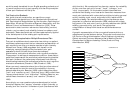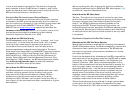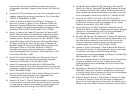
7
in clinical and research applications. The short form is typically
what is referred to when the BPI is cited in research, and it is the
version we describe below. Most psychometric evaluations of the
BPI have been performed on the short form.
Scoring the Brief Pain Inventory as an Outcome Measure
A recent consensus panel recommended that the two domains
measured by the BPI— pain intensity (severity) and the impact of
pain on functioning (interference)— be included as outcomes in all
chronic-pain clinical trials (IMMPACT, Turk et al., 2003). The
IMMPACT panel (www.immpact.org
) specifically identified the
interference items of the BPI, rated on a 0–10 scale, as one of the
two scales recommended for assessment of pain-related
functional impairment (Dworkin et al., 2005).
How to Score the BPI: Pain Severity
The BPI assesses pain at its “worst,” “least,” “average,” and “now”
(current pain). In clinical trials, the items “worst” and “average”
have each been used singly to represent pain severity. A
composite of the four pain items (a mean severity score) is
sometimes presented as supplemental information. The use of
these single items is supported by the IMMPACT recommendations
for assessing pain in clinical trials (Dworkin et al., 2005; Turk et al.,
2006; Dworkin et al., 2008) and by the FDA Draft Guidance for
Industry: Patient-Reported Outcome Measures (Food and Drug
Administration, 2006). However, the BPI’s developers recommend
that all four severity items be used, because the models for
validation of the BPI included all four items.
How to Score the BPI: Pain Interference
The BPI measures how much pain has interfered with seven daily
activities, including general activity, walking, work, mood,
enjoyment of life, relations with others, and sleep. BPI pain
interference is typically scored as the mean of the seven
interference items. This mean can be used if more than 50%, or
four of seven, of the total items have been completed on a given
administration.
8
We are exploring the utility of scoring the activity and affective
dimensions described above (WAW and REM, see diagram [link])
as arithmetic means of these sets of items.
How to Score the BPI: Other Items
The item, “Throughout our lives, most of us have had pain from
time to time (such as minor headaches, sprains, and toothaches).
Have you had pain other than these everyday kinds of pain
today?” is a YES/NO preliminary screening question at the
beginning of the BPI. This item is optional and we have not
evaluated its psychometric properties. The BPI also asks the patient
to indicate the percentage of relief provided by pain treatments
or medications, but we have not found this item to be very useful
in our studies.
Psychometric Properties of the Brief Pain Inventory
Dimensions of the BPI: Two-Factor Structure
Several approaches have explored the underlying dimensions of
the BPI. As described above, the BPI was designed to capture two
dimensions of pain: severity and interference. The BPI was also
intended to capture two components of interference— activity
and affect (emotions).
One of the first studies of the dimensions of the BPI compared the
factor structure of four language versions of the BPI used to assess
cancer pain in the United States, Mexico, the Philippines, and
Vietnam (Cleeland, 1990). Factor analysis was applied to the
matrix of intercorrelations of the item scores of each sample. For
each language version, the same two factors emerged with an
eigenvalue greater than 1: the first factor comprised the pain
interference items and the second factor comprised the pain
severity items. The similarity of the factor loading among the
language versions indicated that patients experiencing cancer
and pain, living in various countries and speaking various
languages, responded to the items in a similar fashion.
This two-factor structure was confirmed in a large national study
conducted in the U.S. by the Eastern Cooperative Oncology
Group. Outpatients (N= 1261) with recurrent or metastatic cancer


















